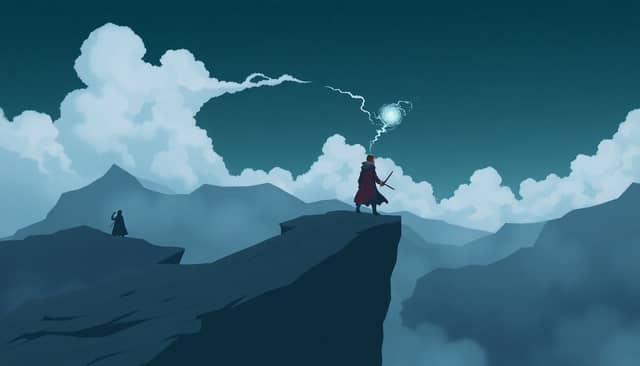Table of Contents
Getting ready to write a fantasy novel can feel overwhelming, especially when it comes to plotting out the story. But don’t worry—if you start by knowing your characters and the world they live in, everything else will fall into place more easily. In this guide, I’ll show you simple steps to build your plot, from setting up your hero to planning the big moments, so your story stays on track and keeps readers hooked.
Key Takeaways
Key Takeaways
- Start by knowing your main characters—what motivates them, their strengths, flaws, and where they begin. Make them relatable and clear to guide the story.
- Build a detailed world with unique landscapes, magic, and cultures early on. Use these details to influence your plot and create an immersive setting.
- Identify the biggest moments in your story—like victories or revelations—and plan how your characters will reach them step by step.
- Define your main conflict and villain, making sure they have believable motives. This keeps the story compelling and the stakes high.
- Clarify what’s at risk and why your hero cares. Strong motivations and high stakes keep readers engaged and eager to see what happens.
- Use your setting as a tool for storytelling—let it shape obstacles, clues, and surprises that drive the plot forward.
- Create a one-sentence premise that captures your story’s core—your hero, goal, conflict, and stakes. It keeps you focused and helps with pitches.
- Plan your big moments and how to reach them with smaller scenes. This helps your story flow smoothly and keeps the reader interested from start to finish.

Step 1: Know Your Main Characters and Setting
Define Your Protagonist and Their Starting Point
Start by figuring out who your hero is and where they are at the very beginning.
Make them relatable—are they a young apprentice, a seasoned warrior, or a reluctant hero?
Think about their goals—what do they want more than anything?
Are they chasing a lost loved one, seeking revenge, or trying to save their world?
Get clear on their strengths—do they have a special skill, magic ability, or sharp mind?
And also consider their challenges—what keeps them from reaching their goals?
Knowing these details helps you create a character readers will root for from page one.
For example, if your hero starts off unsure of themselves but overcomes that doubt, it adds a satisfying arc.
Remember, a strong protagonist with a clear starting point makes plotting their journey much easier.
Want to make your hero more interesting? Introduce a flaw or a secret early on—it makes for better storytelling.
This foundation sets the stage for everything that happens next in your story.
Build the World from the Start
Next, paint a vivid picture of your fantasy world so readers know what makes it special.
What are its key features? Think about landscapes—mountains, forests, or mysterious cities.
Describe the magic systems—are they common, rare, or dangerous?
Include details about cultures, customs, or political systems that influence your story.
Show how the setting affects your characters—does a treacherous river build tension or a bustling market reveal character relationships?
Introduce essential worldbuilding elements early to anchor readers in your universe.
For example, if your world has unique magic rules, hint at them in the opening scenes.
Details like these shape the story’s tone and keep your plot grounded.
Remember, a well-developed setting isn’t just backdrop—it impacts every move your characters make.
Use setting to create conflicts, surprises, or clues that drive the story forward.
Starting with a rich world makes your fantasy story more immersive and memorable.
Step 2: Identify Your Story’s Big Moments
List Major Payoff Moments
Decide on the big events that will matter most in your story—these are the milestones that keep readers hooked.
Think about moments like a hero’s big victory, shocking revelations, or heartfelt reunions.
These are the scenes that readers will talk about long after they finish the book.
For example, maybe your hero finally confronts their villain or discovers a hidden truth.
Make a quick list of these key events—they will guide your plotting.
Remember, these payoffs need to feel earned; build up to them with smaller scenes.
Don’t forget to include emotional highs and lows so the story feels balanced.
By identifying these moments early, you can plan how your story naturally flows from one to the next.
This helps you avoid plot holes or ending without satisfying resolutions.
Keep these big moments in mind as your story unfolds—they’re the threads that tie everything together.
Plan How to Reach These Moments
Once you know your big scenes, map out smaller events that lead up to them.
Think of these as stepping stones—small victories, setbacks, and discoveries.
Use these moments to deepen your characters—show their growth or struggles.
Raise the stakes gradually—if your hero is chasing a magic artifact, maybe they face tests and enemies along the way.
Include plot twists or surprises that make reaching each milestone more exciting.
For example, a false lead or betrayal can make the payoff scene even more impactful.
These smaller scenes can also serve as pauses—giving your readers breath before the next big reveal.
Plan the order carefully: each event should naturally lead to the one after, creating momentum.
If you’re stuck, ask yourself: what’s the logical step my characters take to arrive at this big moment?
Mapping this out ensures your story has a solid, engaging rhythm from start to finish.

Step 3: Define Your Main Conflict and Antagonist
Understanding the core struggle in your story is key to keeping readers invested.
Ask yourself what your hero is fighting for or against.
Is it a specific villain, a corrupt system, or even their own doubts?
Make sure this conflict pushes the story forward instead of feeling like filler.
If your story lacks a clear enemy, consider conflicts like internal struggles or nature challenges.
Does the antagonist have real motives that connect to your hero’s goals?
For example, a dark sorcerer might think they’re saving the world in their own way—giving depth to the conflict.
Research shows that stories with well-crafted villains see higher reader engagement.
Create a character or force that’s believable and has reasons behind their actions.
This makes the showdown more satisfying when it finally happens.
Think about how this opposition complicates your hero’s journey and heightens tension.
Step 4: Clarify Stakes and Motivations
Your hero needs a reason to care, and readers want to feel the stakes too.
Show why the goal matters—whether it’s saving a loved one, stopping an ancient evil, or claiming a throne.
Make their motivation relatable enough that readers root for them.
For example, if your protagonist’s goal is to restore their broken family, highlight their emotional drive in early scenes.
What’s at risk if they fail? Think beyond personal loss—will the world be plunged into chaos?
High stakes make the story more gripping and keep the pages turning.
In recent years, sales data shows that stories with clear stakes, especially in the romance and fantasy genres, perform well.
A bit of unpredictability or a ticking clock can boost the tension significantly.
For instance, if the hero’s magic amulet only works for one day, every decision counts.
Reminding your readers of these risks keeps them engaged through every twist and turn.
Step 5: Use the Setting as a Plot Tool
Your world isn’t just a fancy backdrop; it can shape your story’s direction.
Think about how landscapes, cultures, and magic affect what your characters do.
A cursed forest might be more than just spooky scenery—maybe it’s a trap or holds clues to a mystery.
If your story features a magic system, show its rules early so you can build conflicts around it.
For example, if magic is rare and dangerous, characters will think twice, and plot twists can revolve around this limitation.
Details about political systems or cultural customs can create obstacles or alliances.
In Canadian fantasy sales, most of the top titles fall into categories like contemporary fantasy, which often blend setting with plot.
Use setting details to foreshadow events or introduce surprises—like an ancient prophecy hidden in a city archive.
Remember, a well-crafted setting makes your world feel real and influences every decision your characters make.
It’s a powerful way to add depth without extra exposition and keeps your story grounded in its universe.
Step 6: Write a Clear One-Sentence Premise
This one sentence acts as your story’s GPS, capturing the essence of your book.
It should include your hero, their main goal, the central conflict, and the stakes.
For example: “A young mage must stop a rising darkness threatening her homeland, risking everything to save her people.”
Keep it simple but packed with meaning—this helps you stay focused during the writing process.
Being able to boil your story down helps with pitching, marketing, and keeping your story on track.
A strong premise can even act as a guiding beacon during rewrites or when you hit writer’s block.
If it feels too long or complicated, try breaking it down or rephrasing until it’s punchy and clear.
This little line keeps your whole story aligned with the original idea and appeals to your target readers.
FAQs
The first step is to understand your main characters and setting by defining your protagonist, their goals, and the world they inhabit. This sets a strong foundation for your story.
List major events like character reunions or big reveals, then plan smaller plot points that lead to these moments, helping to build tension and develop your story smoothly.
Establishing the central struggle keeps your story focused and drives the plot forward, ensuring that the protagonist’s goals and obstacles remain clear and engaging.
The setting shapes the story by providing unique cultures, environments, and magic systems that influence characters, conflicts, and plot developments overall.



